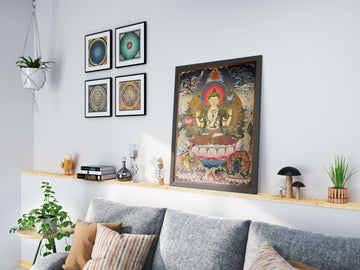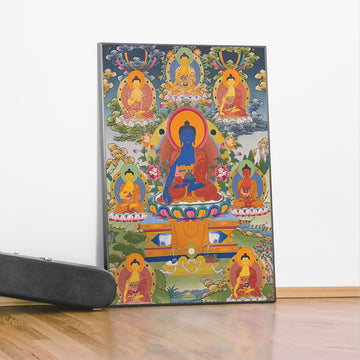The Medicine Buddha, also known as Bhaisajyaguru, is a highly revered figure in the Buddhist tradition. Depicted in stunning thangka paintings, the Medicine Buddha is believed to be the embodiment of the healing power of Buddhism.
Thangkas are traditional Tibetan Buddhist paintings that are typically made on cotton or silk and depict various deities, mandalas, and other religious symbols. In thangka paintings of the Medicine Buddha, he is often shown seated on a throne, holding a bowl of medicinal herbs, and surrounded by a lapis lazuli background. The color blue is associated with the Medicine Buddha, and the lapis lazuli background represents his connection to the celestial realm.
Tibetan Buddhists believe that the Medicine Buddha has the ability to heal physical and mental suffering, and his teachings focus on compassion and the elimination of suffering. As a protector deity, the Medicine Buddha is often invoked in times of illness or when seeking relief from suffering. Tibetan Buddhists may recite the Medicine Buddha mantra as a form of spiritual practice and for the purpose of healing. Thangka paintings of the Medicine Buddha are commonly used in Tibetan monasteries as aids in meditation and visualization practices, and are also found in homes as decorative items or offered in temples.
But where does the Medicine Buddha come from, and how did he become such a revered figure in the Buddhist tradition?
According to Buddhist tradition, the Medicine Buddha was a historical figure who lived in India around the 5th century BCE. He was a prince named Siddhartha who renounced his royal status and became a monk. Through his practices and teachings, Siddhartha attained enlightenment and became known as the Medicine Buddha.
In Tibetan Buddhism, the Medicine Buddha is seen as a guide on the path to spiritual enlightenment and liberation from suffering. It is believed that the root causes of suffering are rooted in ignorance and negative actions, and that through spiritual practice and the cultivation of compassion and understanding, suffering can be overcome. The Medicine Buddha's teachings encourage practitioners to cultivate the qualities necessary to achieve enlightenment and overcome suffering.
In summary, the Medicine Buddha, also known as Bhaisajyaguru, is a central figure in Tibetan Buddhism and is revered as the embodiment of the healing power of Buddhism. Depicted in beautiful thangka paintings, the Medicine Buddha is invoked for his healing abilities and as a guide on the path to enlightenment. Thangka paintings of the Medicine Buddha are widely used in Tibetan monasteries and homes as aids in meditation and visualization, as well as decorative and offering items. Through his teachings and guidance, the Medicine Buddha helps practitioners to cultivate compassion and understanding and overcome suffering on the path to spiritual enlightenment.





